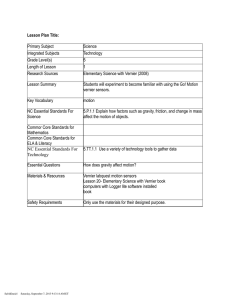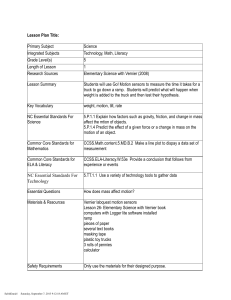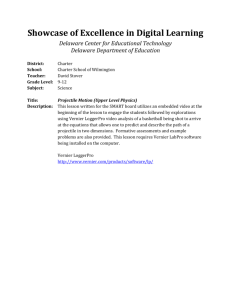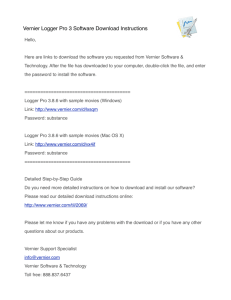Unit Plan Title: Let the Force be with you! Primary Subject
advertisement
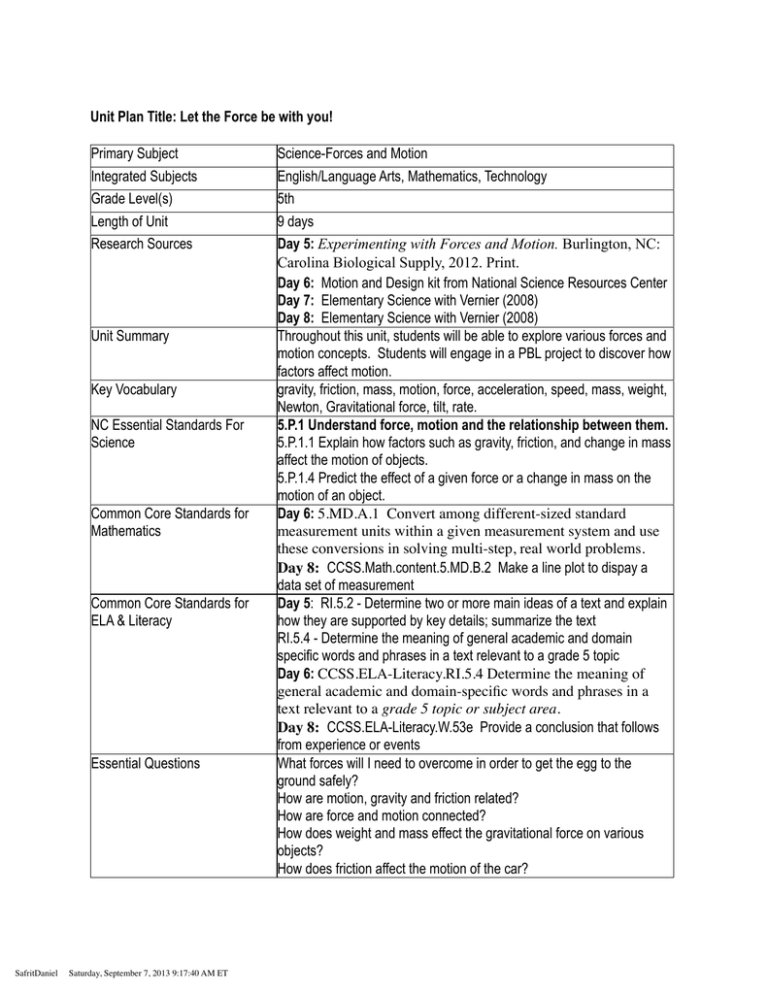
Unit Plan Title: Let the Force be with you! Primary Subject Integrated Subjects Grade Level(s) Length of Unit Research Sources Unit Summary Key Vocabulary NC Essential Standards For Science Common Core Standards for Mathematics Common Core Standards for ELA & Literacy Essential Questions SafritDaniel Saturday, September 7, 2013 9:17:40 AM ET Science-Forces and Motion English/Language Arts, Mathematics, Technology 5th 9 days Day 5: Experimenting with Forces and Motion. Burlington, NC: Carolina Biological Supply, 2012. Print. Day 6: Motion and Design kit from National Science Resources Center Day 7: Elementary Science with Vernier (2008) Day 8: Elementary Science with Vernier (2008) Throughout this unit, students will be able to explore various forces and motion concepts. Students will engage in a PBL project to discover how factors affect motion. gravity, friction, mass, motion, force, acceleration, speed, mass, weight, Newton, Gravitational force, tilt, rate. 5.P.1 Understand force, motion and the relationship between them. 5.P.1.1 Explain how factors such as gravity, friction, and change in mass affect the motion of objects. 5.P.1.4 Predict the effect of a given force or a change in mass on the motion of an object. Day 6: 5.MD.A.1 Convert among different-sized standard measurement units within a given measurement system and use these conversions in solving multi-step, real world problems. Day 8: CCSS.Math.content.5.MD.B.2 Make a line plot to dispay a data set of measurement Day 5: RI.5.2 - Determine two or more main ideas of a text and explain how they are supported by key details; summarize the text RI.5.4 - Determine the meaning of general academic and domain specific words and phrases in a text relevant to a grade 5 topic Day 6: CCSS.ELA-Literacy.RI.5.4 Determine the meaning of general academic and domain-specific words and phrases in a text relevant to a grade 5 topic or subject area. Day 8: CCSS.ELA-Literacy.W.53e Provide a conclusion that follows from experience or events What forces will I need to overcome in order to get the egg to the ground safely? How are motion, gravity and friction related? How are force and motion connected? How does weight and mass effect the gravitational force on various objects? How does friction affect the motion of the car? Materials & Resources Safety Requirements Activities/Procedures • Essential Question • Explore/Engage • Explain • Elaborate (Inquiry) • Evaluate SafritDaniel Saturday, September 7, 2013 9:17:40 AM ET Day 2-4: iMovie, cotton balls, packing peanuts, sheets of foam paper, sheets of bubble wrap, sheets of cardstock, tissues, paper towels, balloons, straws, paper clips, quart size bags, string, tape, student list of materials to bring from home Day 5: 1.) Experimenting with Forces and Motion Textbook Reader (There are 14 books at Horizons Unlimited) 2.) Spring Scales (enough for groups of 2-3) 3.) Science notebooks to record data or an alternative way to record data (i.e. ipads) 4.) Sticky Notes 5.) Washers 6.) String 7.) OPTIONAL - Vernier LabQuest and Probes: Use the Force Probe Day 6: K’NEX car, yard stick, carpet, linoleum, sidewalk Day 7: Vernier labquest motion sensors Lesson 20- Elementary Science with Vernier book computers with Logger lite software installed book Day 8: Vernier labquest motion sensors Lesson 26- Elementary Science with Vernier book computers with Logger lite software installed ramp pieces of paper several text books masking tape plastic toy trucks 3 rolls of pennies calculator Only use the materials for their designed purpose. Day 1: Students will begin by taking a pretest to activate their prior knowledge of forces and motion. (Teacher created ClassScape assessment- school assessment district-shared-trexlejd-Pre-Post test Forces in Motion) Day 2-4: Students will work on a Problem based learning activity Day 5: Force of gravity Day 6: How friction affects motion. Day 7: Working with Vernier sensors and probes Day 8: Activity using the GO! Motion sensor. Day 9: Students will take post test. (Teacher created ClassScape assessment.) Accommodations for Differentiated Instruction Cross Curricular Integration Day 5: Teacher will group students during the reading activity based off reading needs. Teacher will individualize number of facts needed during the writing exercise based on students levels. Day 6: Visual: Provide a flow chart to help students organize the steps for following science process skills. Auditory: Ask students for oral summaries of their progress concerning the experiment. Also, students will work collaboratively to discuss ideas, findings and observations. Kinesthetic: Dramatization of friction Day 7: Visual: The teacher will project the logger lite program to the white board. Auditory: The motion sensors can emit a beeping sound to alert the student to movement. Kinestetic: The student can dramatize the motion. Day 8: Visual: The teacher will project the logger lite program to the white board. Auditory: The motion sensors can emit a beeping sound to alert the student to movement. Kinestetic: The student can dramatize the motion. Day 5: ELA is integrated through a reading selection, writing a summary, and verbal communication with groups. Day 6: Students will measure the distance traveled in meters and convert to centimeters. Day 7: Students will discuss their motion data that was collected on the vernier lab quests. Day 8: Students will graph their motion data on the computer and compare and contrast the results. Created by Email Wendy Distefano distefwb@rss.k12.nc.us Cynthia Graber grabercl@rss.k12.nc.us Leslie Hunsucker lhunsucker@northhillschristian.com Stacy Rosenbaum rosenbaumsg@rss.k12.nc.us Daniel Safrit safritdc@rss.k12.nc.us Jennifer Walters waltersjt@rss.k12.nc.us Supporting Documents PBL activity / description PBL rubric http://images.bie.org/uploads/useful_stuff/ Upper_ES_Presentation_Rubric_for_PBL_FINAL2013.pdf SafritDaniel Saturday, September 7, 2013 9:17:40 AM ET
